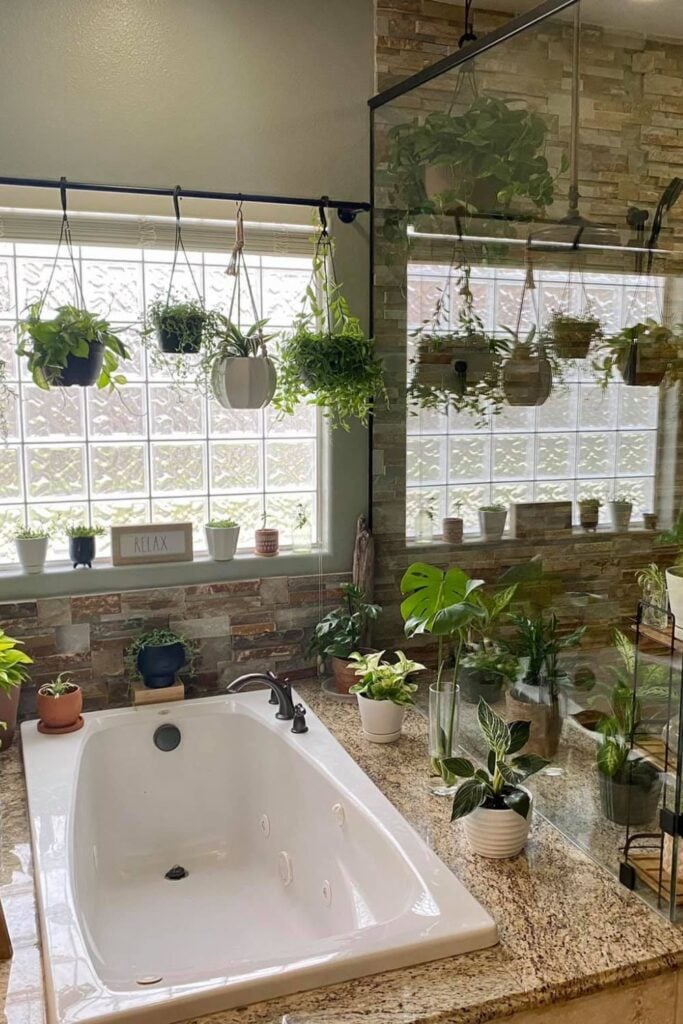Bathrooms are warm and humid. This microclimate often resembles the tropics—the natural habitat of many houseplants. Indoor greenery pairs beautifully with porcelain fixtures and tile, softening the bathroom’s somewhat cool, sleek look.
Lush foliage near water creates a soothing, spa-like atmosphere right at home, helping you feel calm and rejuvenated.
Contents
Bathrooms with Windows
It’s amazing how well plants can thrive in a bathroom, even with the tiniest bit of daylight. In my own bathroom, there are two windows.

One is large, facing north, but it’s always covered by wooden blinds and hardly lets in any light. The other is a small, narrow window up high on a northwest-facing wall—truly the only source of natural light.
Still, I’ve successfully grown a Christmas cactus (Schlumbergera, also known as Holiday cactus), a Boston fern (Nephrolepis), a Moth orchid (Phalaenopsis), and a Peace lily (Spathiphyllum) for several years on the windowsill of the window that’s covered by blinds. The last two, in fact, seemed to bloom continuously, as if they never wanted to stop.
You might not be the type to give your houseplants meticulous care every day. Sometimes you forget about them for weeks, and when you finally remember, place the pots in a sink filled with warm, unfiltered tap water for about 30 minutes.
They get a thorough drink and a quick rinse to wash off any dust. I believe the reason they still grow and bloom is the healthy microclimate in the bathroom. Limited daylight often promotes a longer flowering period, so that might be another secret behind their success.
Bathrooms Without Windows
This situation is less favorable for plant lovers, but it’s not hopeless. One option is to install grow lights. Although these lights can be pricey and may take up space in the bathroom, they ensure that plants receive adequate illumination.

A simpler solution is to periodically move plants into the bathroom. Newly blooming plants will enjoy an extended flowering period in the bathroom because of the lower light levels. By placing them in suitable pots, you can decorate your bathroom for about one to two months.
After that, give them a “spa retreat” of their own—transfer them to a place with stronger lighting and richer feeding, like a garden or a balcony, and rotate them with other plants.
Keep in mind that variegated plants (with multicolored or patterned leaves) need more light to maintain their leaf patterns. In low-light bathrooms, choose shade-tolerant plants with solid green foliage.
How to Arrange Plants in the Bathroom
If possible, keep potted plants on windowsills or other flat, horizontal surfaces. Hanging plants (ampelous varieties) work well mounted on a free wall, away from where you’ll bump into them.

Avoid placing pots directly beside the sink, bathtub, or shower, where they’ll constantly get in your way. Eventually, you might knock them onto the tile floor, breaking the pot or damaging the plant.
Also, not all moisture-loving plants appreciate direct sprays of water on their leaves, flowers, or the base of their rosette stems. Never keep houseplants near a radiator or any strong heat source.
For fertilizing all indoor plants (except orchids), I use a long-acting, granular universal fertilizer mixed into the soil during repotting. Orchids require a specialized fertilizer.
For plants that don’t tolerate their soil drying out, add a hydrogel to the potting mix when you repot to help maintain consistent moisture levels.
Which Houseplants Are Suitable for the Bathroom?
1- Phalaenopsis (Moth orchids) and Paphiopedilum (Lady’s slipper orchids): These orchids prefer diffused, gentle light and high humidity.
2- Saintpaulia (African violet): These lovely flowers thrive in high humidity and soft, diffused light. Just keep water off their leaves and blooms. Their miniature size makes them perfect for even the smallest bathrooms.
3- Dracaena sanderiana (Lucky bamboo): A hardy, water-loving plant with an exotic appearance. Lucky bamboo has gained popularity in recent years and is prized by those who follow Feng Shui, as it’s believed to bring luck and prosperity. You can grow it in soil or hydroponically (in water with fertilizer).
It dislikes direct sunlight, prefers partial shade, and tolerates warm temperatures if watered generously and frequently.
Grown hydroponically, it looks especially striking in clear, sturdy glass vases of various shapes. Try placing a square vase next to a round one, both filled with the straight, leafless stems of lucky bamboo.
4- Camellia (Camellia): Camellias are considered challenging indoor plants, particularly in rooms with central heating. Yet in nature, they’re quite undemanding. (I have one in my garden, and it grows happily in the shade year-round, blooming every spring as if it’s on a mission!)
Camellias don’t like dry air, bright light, or excessive heat, and hot, dry conditions are deadly for them. A moist bathroom with diffused light is a perfect spot for a camellia, which stays decorative all year.
5- Nephrolepis (Boston fern): Sturdy and fast-growing, these ferns can be placed on both horizontal and vertical surfaces, such as in hanging baskets. They love high humidity and need room to spread out, so they’re best for larger bathrooms.
6- Sarcococca (Sweet box): An exceptionally ornamental plant related to the boxwood family. In some regions, sweet box grows outdoors in the garden; in colder areas, people cultivate it indoors. Sarcococca blooms in winter and spring, producing flowers with an incredibly intense fragrance.
At the same time, it bears red and black berry-like fruits from the previous season. Sarcococca plants are self-pollinating, so they don’t need a partner to form those beautiful berries. They’re not picky about lighting conditions.
7- Dieffenbachia (Dumb cane): Known for its stunning two-tone leaves (usually green and cream). Some types have gigantic leaves. Dieffenbachia loves warmth, light, and humidity—perfect reasons to keep it in a bathroom with a window.
8- Schlumbergera (Christmas cactus): A gorgeous plant that’s not too demanding of light and can be grown as a hanging plant. Christmas cactus sets its buds when the days shorten and the temperature drops. It can thrive in a bathroom environment, at least during certain periods in its growth cycle.
9- Sansevieria (Snake plant, also known as Mother-in-law’s tongue): Named for its long, wide, flat leaves with stripes, it’s one of the easiest plants to grow. Not picky about light, watering, or humidity. There are many species grown in pots.
Sansevieria has strong but not deep roots, so use wide, shallow pots. If you hang the pot instead of placing it on a surface, the plant can send roots and leaves through the drainage holes. That’s because it forms offshoots on aerial rhizomes right at its base.
10- Gardenia : This plant has a reputation for being fussy, as hobbyists often struggle to get it to bloom indoors. Try placing a gardenia in a well-lit bathroom to give it the humidity it craves.
Gardenias dislike direct sun and prefer diffused light. Known for their white, fragrant flowers, gardenias are a treat if you can get them to bloom.
11- Chlorophytum comosum (Spider plant) and Aspidistra elatior (Cast-iron plant): Both are from the lily family and are extremely hardy, low-maintenance, shade-tolerant plants. A spider plant looks great in a hanging basket or cascading from a shelf or other horizontal surface.
12- Anthurium (Anthurium): A striking plant from the Araceae family with showy red “waxy” flowers. Anthuriums dislike direct sunlight and need extremely high humidity—up to around 90%—which makes a bathroom with some natural light a perfect haven for them.
13- Aglaonema (Chinese evergreen): Like most aroids, it prefers diffused light or partial shade and high humidity.
14- Philodendron (Philodendron): A climbing plant with many species grown indoors. It’s not demanding of light, but it does need consistently moist soil and humid air. Philodendrons can be grown as hanging plants. Since they grow quickly, they’ll need occasional pruning and ample space.
15- Spathiphyllum (Peace lily): Prefers diffused light, moderate watering, and high humidity. Even with minimal natural light in my bathroom, my peace lily never stopped blooming.
16- Maranta leuconeura (Prayer plant) and other species of Maranta: An elegant, decorative foliage plant that prefers diffused light, high humidity, and regular watering.






